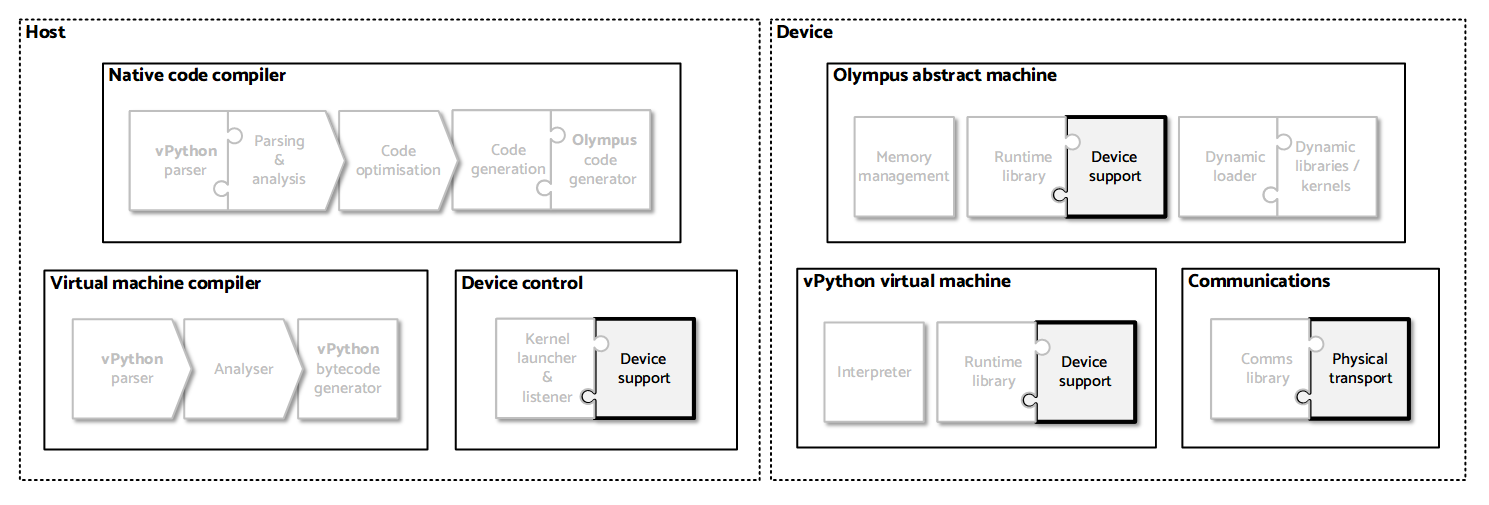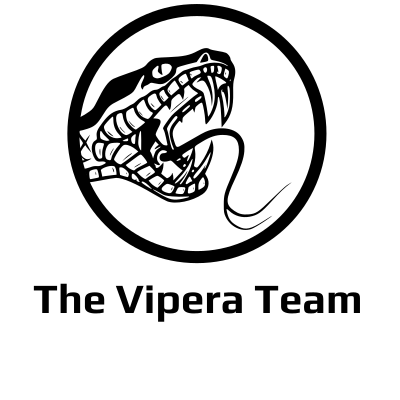The layered and plug-in architecture of Vipera greatly simplifies the process of adding a support for a new micro-core device. As Vipera already supports a number of different micro-core architectures, the platform specific sections of the framework have been isolated to minimise the impact of device-specific features of a target architecture.
Table of Contents
The key components that are likely to require modification to support a new device are highlighted in the following diagram:

Areas of change
Unless there are specific features of the new device that require additions to existing languages e.g. vPython, no modifications are requried to either the Olympus native code compiler or the Vipera virtual machine compilers. Areas of change include: the device support in Device control on the host, the device support in both the Olympus abstract machine and Vipera / vPython virtual machine running on the device and possibly the underlying physical transport of the Communications component, if the device is significantly different from existing supported devices. However, the abstract machine, virtual machine and comms library themselves should not require modification as they already abstract over different micro-core device architectures.
For embedded devices that do not have memory hierarchies, changes may be required within the language compilers to prevent applications using shared memory etc. However, this is a simple change that does not impact the rest of a Vipera compiler. Similarly, for example, adding support for vector instuctions of a new RISC-V native code target would only impact the Olympus code generator and abstract machine; none of the other phases / components of the native code compiler would require modification.
Device specifics
Each micro-core device has its own subdirectory in the devices directories of the Vipera codebase for custom configuration and device-specific files.
vPython
If we look at the vPython codebase, we see that we have a directory for each of the supported micro-core devices (Adapteva Epiphany-III, Xilinx MicroBlaze and RISC-V) and one for the host:
devices
├── epiphany
│ ├── epiphany-runtime.c
│ ├── epiphany-shared.h
│ ├── linker.ldf
│ ├── main.c
│ ├── main.h
│ └── makefile
├── host
│ └── host-shared.h
├── microblaze
│ ├── main.c
│ ├── main.h
│ ├── makefile
│ ├── microblaze-runtime.c
│ └── microblaze-shared.h
└── riscv
├── init.S
├── libsfloat.a
├── mailbox.h
├── main.c
├── main.h
├── makefile
├── picorv32.ld
├── riscv-runtime.c
└── riscv-shared.h
NOTE: The device subdirectories each contain their own specific
makefilesand linker files e.g.epiphany/linker.ldfandriscv/picorv32.ld, where appropriate. The linker files are required to define the memory map for vPython as the devices are bare-metal and do not run an Operating System.
The <device>-runtime.c file contains the device-specific function definitions required by vPython interpreter and the <device>-shared.h file contains the definitions that are shared between the device virtual machine and the device support functions running on the host. The main.h and main.c files contain the standard C main() function, tailored to the specifics of each device. For certain devices, such as the PicoRV32 RISC-V soft-core, custom C support libraries (e.g. libsfloat.a) and processor start-up code (e.g. init.S) are required, which are bound to the vPython binary.
Olympus
The Olympus native code compiler framework does not currently require device-specific configuration or files. However, the Olympus abstract machine does require device-specific definitions within the device support area of the runtime library. For example, the Olympus abstract machine is 32 bit for all the currently supported micro-core devices but it can be configured to be a different size e.g. 64 bit on an x86 host or 16 bit on embedded devices, if required. The definitions are held within types.h in the main Olympus source directory, which also holds processor-specific alignment requirements and processor endianness. Olympus currently supports a number of processor architectures (Epiphany, MicroBlaze, RISC-V, ARM, x86, MIPS, SPARC and PowerPC) and C compilers (GCC, Clang, Watcom, TCC and SDCC).
To ensure cross-platform portability, device support customisation code should use the following Olympus pre-defined data types and structures:
| Type | Description |
|---|---|
Int |
Integer variable |
Real |
Floating point variable (single precision) |
Bool |
Boolean variable |
Char |
Character variable |
String |
String variable (includes length) |
Array |
Array variable (includes dimensions / shape) |
Complex |
Complex number variable |
Pntr |
A pointer / reference variable |
Object |
An object variable |
Proc |
A lambda function variable (takes an Env and Object parameter) |
Frame |
A function’s stack frame |
Env |
An environment (vector of Frames) |
Value |
Generic memory location to hold values within a Frame |
StackControlWord |
An encoded value within the stack frame (size and number of pointers) |
Level |
The lexical (scope) level of a variable |
Offset |
A variable’s offset within a Frame |
Alignment |
Memory alignment value |
Size |
The size of a stack frame |
Address |
An address value |
ArrayDimCount |
The number of dimensions in an array |
ArrayDim |
An array dimension (size) |
ArrayIndex |
An array index value |
HeapBlockSize |
The size of a block within the Olympus abstract machine heap |
Memory |
An Olympus abstract machine memory map (includes environment, stack and display) |
Word |
Processor architecture word value (32 bits on current micro-cores) |
HWord |
Half word |
DWord |
Double word |
ValueDefn |
A vPython interpreter variable value (includes type information) |
SymbolNode |
A vPython interpreter variable symbol table node (ID and value) |
NOTE: There are a set of associated C macros, that should be used in preference to directly accessing Olympus abstract machine structure fields directly, which can be found in the
macros.handmemory.hfiles in the main Olympus source directory. These provide the API into the Olympus abstract machine and will minimise the impact of underlying changes to the implementation on customised device support code or libraries.

